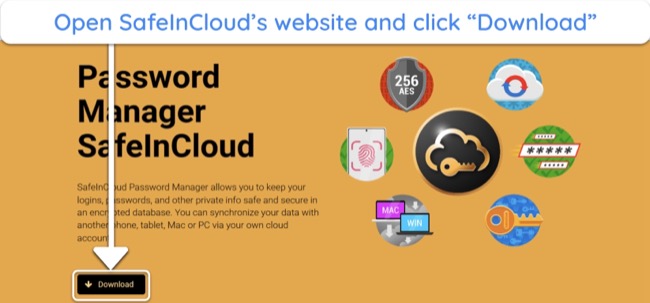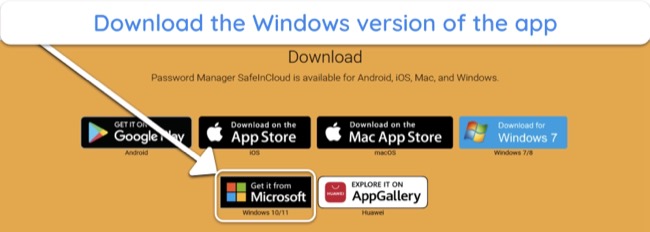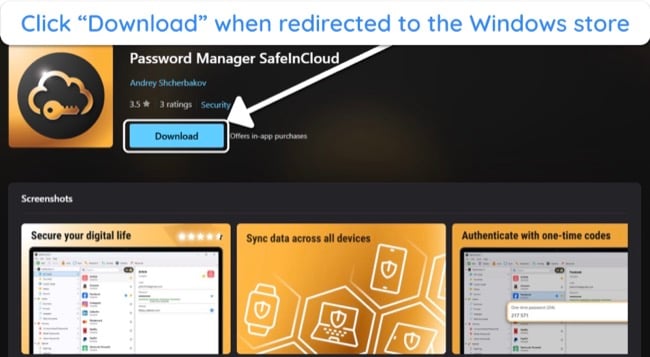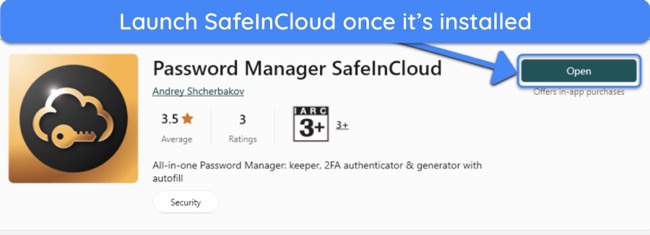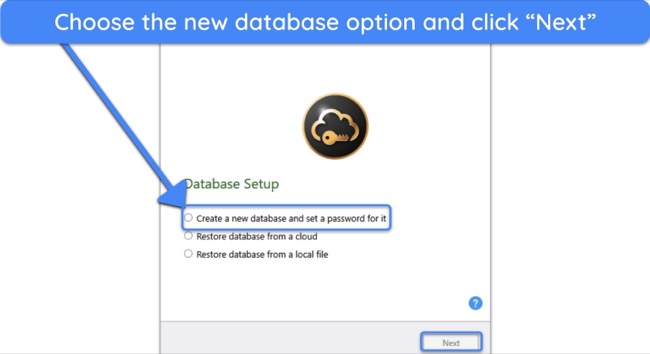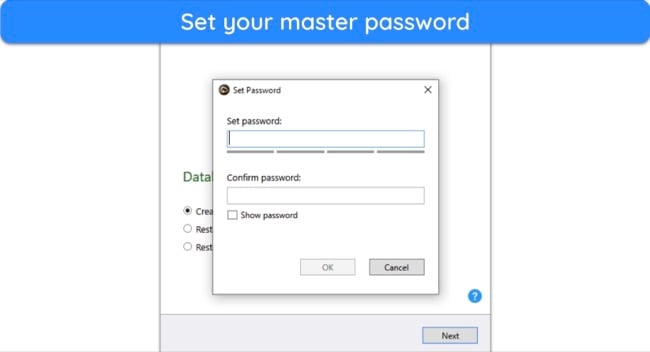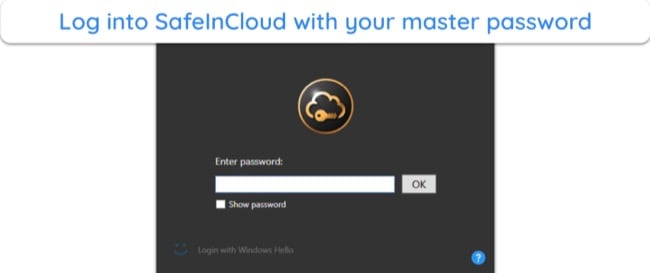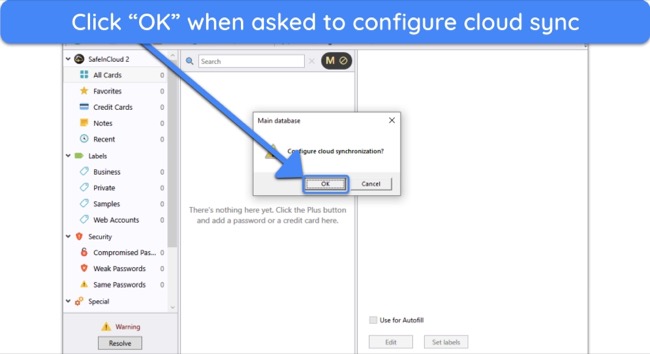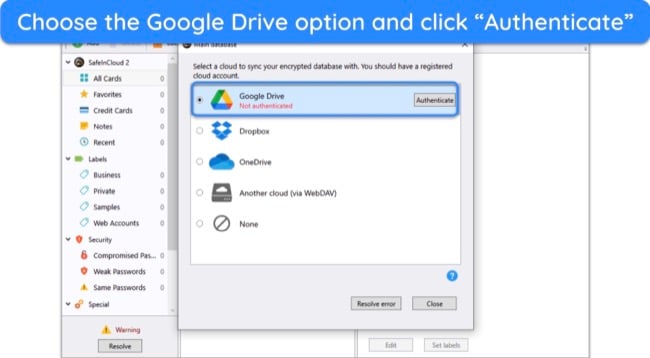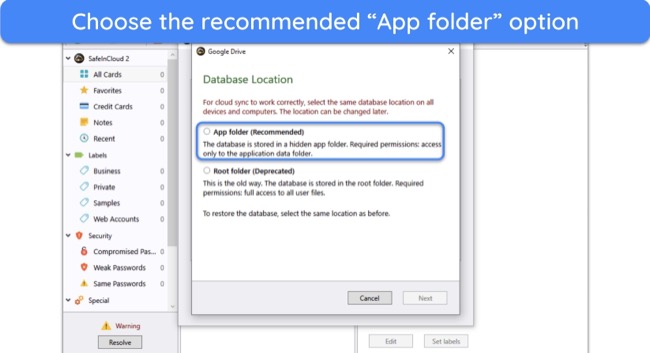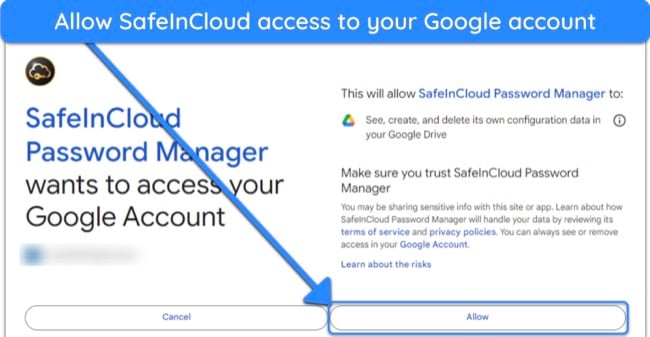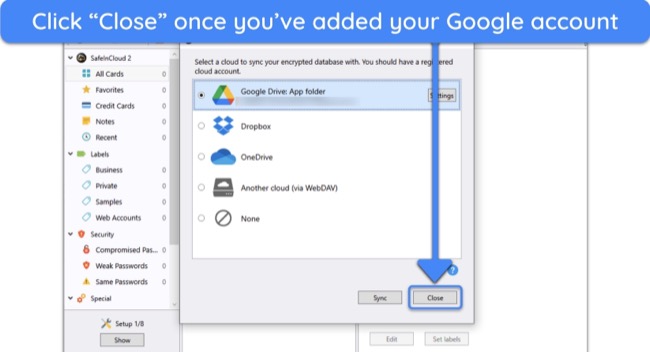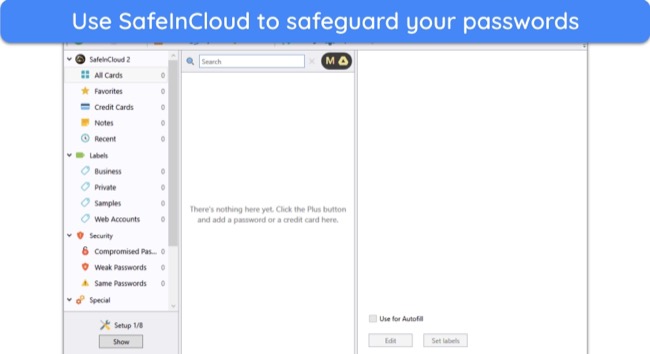SafeInCloud Review 2024 — Is This Password Manager Safe?
SafeInCloud Overview
SafeInCloud seems like a good password manager with reliable security and features, and its second-generation release has added a subscription model to make it more accessible. So, I extensively tested SafeInCloud to learn if it’s as good as the best password managers.
In my tests, I learned that SafeInCloud is good for basic password management. It uses AES 256-bit encryption to secure your passwords and includes auto-save and fill, password generation, and basic sharing. However, it’s missing many features that top password managers have, like passkey support, emergency access, and proper auditing tools.
The free SafeInCloud desktop app is a decent choice, but an alternative like Dashlane is a much better option in most cases. Its apps are more intuitive, it has a better variety of features, and it delivers more value for money.
Try Dashlane risk-free for 30 days
Don’t Have Time? Here’s a 1-Minute Summary
- Well-rounded security. SafeInCloud ensures data security with its AES 256-bit encryption and a zero-knowledge architecture. Read more about its security.
- Limited features. You only get basic features like password generation, auto-save/fill, and simple password sharing. Learn about the password manager’s features.
- Time-consuming setup. Setting up SafeInCloud on desktops and enabling cloud sync is a long process. Discover my experience with SafeInCloud’s apps.
- Lacking support options. There’s only email support and an online knowledge base if you need help. Learn how you can get help for SafeInCloud.
- Not the best value. There’s a free desktop app, but the paid plans for the mobile versions don’t deliver good value. Get more details about its price plans.
Security
Good Password Security but Missing Some Necessary Tools
SafeInCloud delivers reliable password protection. It has unbreakable encryption and a zero-knowledge design to ensure only you know what’s in your vault, and no one else can access it. Plus, it has some extra features like Paranoid Mode for added protection if you’re worried about hackers.
Another noteworthy detail is that SafeInCloud doesn’t have its own servers. It stores the data locally on your device or uses a cloud storage platform, like the following:
- Google Drive
- Dropbox
- OneDrive
- NAS (Network Attached Storage) with WebDAV protocol support
Remember that you must set up the cloud storage feature to enable automatic sync across your devices.
Unfortunately, SafeInCloud is missing some critical tools that most modern-day password managers have. For instance, it doesn’t provide two-factor authentication for vault access.
AES 256-Bit Encryption — Guarantees Security for Everything Stored in Your Database
SafeInCloud secures databases (vaults) with AES 256-bit encryption, the same standard militaries and banks use for data security. This is an impenetrable standard that no one can crack, meaning your vault’s data is always safe if you use a strong master password.
If you enable cloud storage, SafeInCloud always transmits your data in encrypted form, meaning hackers spying on your traffic can’t steal it in transit. Plus, it uses the HTTPS protocol during data transmission, adding an extra layer of security.
Biometric Support and Fast Unlock — Quickly Access Your Database With Your Fingerprint
SafeInCloud lets you access your vaults with biometrics. You can use fingerprints/Touch ID on desktops, while the mobile app allows Face ID and fingerprints for biometrics logins. It also supports full integration with Windows Hello, meaning you can also use your PIN and other methods to access its databases on Windows.
Alongside biometrics, SafeInCloud’s Fast Unlock is another way of quickly accessing your vault. When it’s enabled, SafeInCloud lets you use the first or last 4 characters of your master password to unlock your database.
SafeInCloud occasionally asks you to enter your password, even if you have enabled biometrics and fast unlock. This is a good failsafe to ensure people always remember their passwords — especially important because there aren’t any recovery methods.
Paranoid Mode and Self Erase — Extra Security if You’re Worried About Hackers or Malware Infections
Paranoid Mode and Self Erase features are unique security tools I haven’t seen in other password managers. They’re designed to protect your sensitive data if you’re worried about your device getting breached by malware or hackers.
You should use the Paranoid mode if you’re worried your system has a malware infection. Enabling this mode causes SafeInCloud to unload all data whenever the database is locked, preventing malware from reading through your device’s memory. Plus, it turns off features like auto-fill and fast unlock to ensure that viruses can never see sensitive information.

Self Erase wipes your database after too many incorrect password attempts. The good thing about this feature is that it only wipes your database locally, meaning you can still access it from another device if you have cloud sync enabled. It’s a great feature to enable if you’re worried someone will access your system and try to brute-force their way into your vault.
Overall, SafeInCloud ensures good protection for all your credentials with its encryption, biometric support, and other security features. While I would’ve liked to see two-factor authentication for vault access, I’m still pleased with the app’s overall protection.
Remember that SafeInCloud doesn’t offer a password recovery option, meaning it’s essential to remember your master password. You might still be able to access your vaults if biometrics are enabled, but there’s no way to reset your password if you ever forget.
Privacy — Ensures Your Data’s Privacy With Its Zero-Knowledge Design
SafeInCloud has a zero-knowledge architecture, meaning no one except you knows what’s in your database. Also, it doesn’t have its own servers and uses local storage or a cloud storage method you choose, meaning there’s no way anyone can access your information.
Despite the privacy-focused design, my concern is that SafeInCloud hasn’t been independently audited. Independent audits can confirm if an app behaves and handles data the way it claims to, but there haven’t been any for this app.
Thankfully, there are alternative password managers that have passed independent audits. Among these alternatives, Dashlane is the best overall option. It’s cleared multiple independent audits, giving me complete confidence in its data management practices.
Features
Only Provides Basic Password Management Features
SafeInCloud 2’s features are the same as those of the first-generation variant. So, it includes all basic password management tools, like easy-to-use password storage, auto-save/fill, password generation, and others. However, it’s missing advanced features that the best password managers have, like passkey support, emergency access, and others.
Databases — Well-Organized and Easy-To-Use Storage for Your Sensitive Information
Databases are SafeInCloud’s version of vaults, and I was pleased to see that they’re well-organized and easy to use. You can make multiple databases, each with its own password. Also, the interface lets you quickly navigate through all your logins, add new ones, or edit existing ones.
I also like that SafeInCloud provides labels that help with sorting data. There are 4 default labels to help categorize your information, and you can easily add new ones to organize your information further.
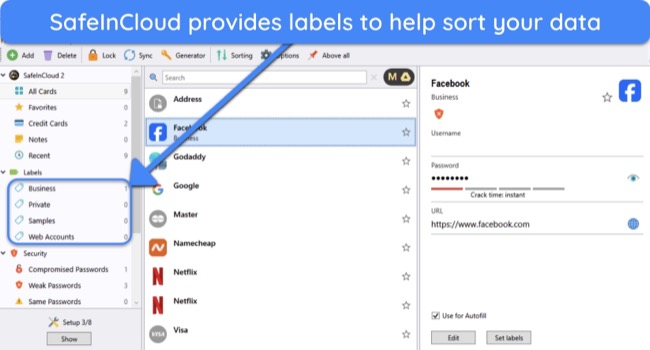
What stands out is that SafeInCloud’s databases let you store all kinds of information. It has preset templates for the following information:
- Logins
- Bank accounts
- Credit Cards
- Passports
There are several other presets alongside the above options, and you can add a custom template for data it doesn’t support by default.
Another highlight of the password manager’s storage is that SafeInCloud lets you add images and files as attachments to any entry. File attachments are limited to 150KB, but there doesn’t seem to be a limit to the images. I tested this by attaching 10 high-resolution images to a file, and SafeInCloud let me add them without any issues.
Auto-Save and Fill — Basic Functionality and Not as Reliable as Competitors
Having good auto-save/fill functionality is critical for a password manager, but I wasn’t pleased with the auto-save and auto-fill tools in SafeInCloud. Before you start using them, you must download the extension on your browser, which has no purpose other than enabling auto-save and auto-fill.
The auto-save was reliable in my tests. I entered my login information across multiple websites like Facebook, Netflix, Namecheap, etc. SafeInCloud prompted me to store my login information every single time. Unfortunately, the auto-save is limited to accounts and credit cards, meaning this app won’t save addresses and other details.
The auto-fill was also decent but suffers the same issue as the auto-save — it’s limited to simple login forms and credit cards. It won’t fill in other details like addresses. Also, I had to click on SafeInCloud’s extension icon every time I wanted to use the auto-fill, which was inconvenient.
![]()
Another thing SafeInCloud lacks is auto-saving/filling information for desktop apps. Competitors like RoboForm offer this feature when you download their desktop apps, and it’s very convenient if you frequently log into several apps on your device.
The app’s auto-save and fill functionality performs similarly on mobile devices. It works well when you’re filling login forms on websites or apps, but it isn’t useful for complicated forms with multiple fields.
Password Generator — Creates Secure Passwords and Has Lots of Customization Options
I’m quite pleased with the password generator SafeInCloud provides. You can use it to create up to 64-character-long passwords, and a button lets you instantly copy the generated password to your clipboard.
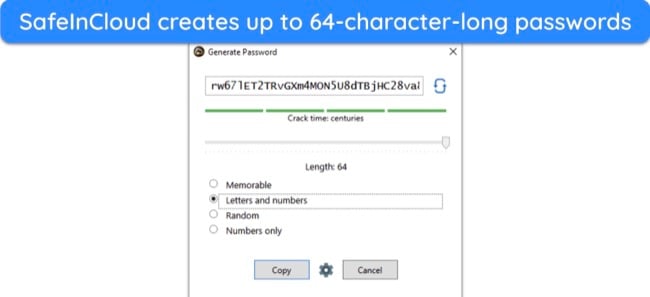
Another highlight of this feature is that SafeInCloud’s password generator is highly customizable. You can set it to include letters, numbers, and special characters. Plus, you can exclude certain characters, letters, or numbers.
There’s also a “memorable” toggle that creates passwords with memorable keywords. These are just as secure and easier to memorize, so I always enabled this feature when generating account passwords.
Password Security — Scans Your Database and Informs About Vulnerable Passwords
Password Security is SafeInCloud’s built-in way of auditing your passwords. It isn’t as good as Dashlane’s Password Health tool or 1Password’s Watchtower. However, SafeInCloud’s Password Security effectively highlights weak, reused, and compromised passwords.
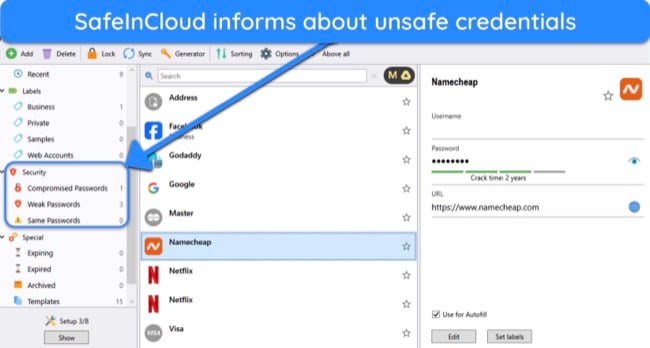
SafeInCloud uses haveibeenpwned.com to gather information about compromised accounts. It’s a reliable service that’s updated regularly with all recent data breaches, so you can trust the results when SafeInCloud tells you about a compromised account.
Sharing — Only Shares Data in an Unsafe Plaintext Format
SafeInCloud lets you share information with others, and it’s much easier to do than other password managers. If you’re using the desktop app, just right-click the entry you want to share and click send. When you do this, SafeInCloud will open your default email client and paste the information into a new blank email you can send anyone.
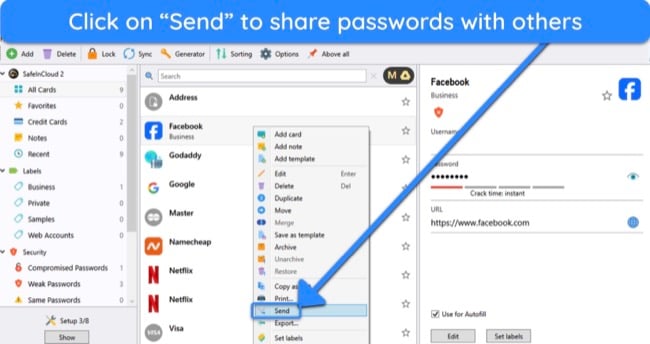
Unfortunately, SafeInCloud’s sharing method isn’t secure at all. It pastes your passwords in plaintext, a huge security risk. Also, the sharing feature on its mobile apps just copies the selected entry onto your clipboard — you must manually share it with a recipient.
Competitors like 1Password offer much safer sharing methods by generating temporary links only recipients can access.
Import/Export — Lets You Conveniently Switch Between Password Managers
SafeInCloud has reliable import/export functionality, making it easy to switch between password managers. Its import feature lets you add passwords from various sources, including other password managers and browsers. Plus, it supports many formats like .CSV, .JSON, .1PIF, and several others.
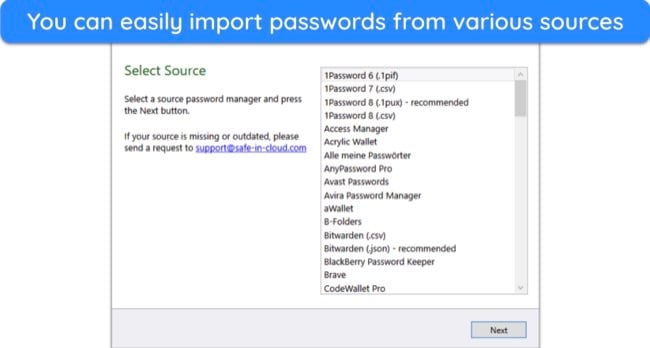
I also like that SafeInCloud lets you export data in several formats, including the following:
- CSV (Comma Separated Values)
- XML (Extensible Markup Language)
- Plaintext
The variety of export options is great, as it makes it easy to switch to another password manager if you want to stop using SafeInCloud.
One downside is that SafeInCloud’s import/export features are limited to its desktop apps. Tapping the Import/Export button in its mobile app just tells you to use its desktop apps to import or export data.
While this app has most of the necessary password management tools, SafeInCloud’s features are lacking compared to the best password managers. There’s no passkey support, secure sharing, or emergency access. Plus, the auditing is limited, and some features aren’t as effective as they should be, like the limited auto-save/fill.
Ease of Use
Simple to Use but Has a Lengthy Setup Process
SafeInCloud’s apps are well-designed and easy to use. However, I was surprised by how lengthy the desktop setup gets when you set up cloud storage. You must follow several extra steps to set it up with a cloud storage provider like Google Drive. In contrast, the best password managers are ready to use as soon as you install their app or extension.
Devices
You can use SafeInCloud on Windows, macOS, iOS, and Android. The Windows app looks slightly outdated but is still easy to navigate and use. Plus, the SafeInCloud 2 mobile apps have the same intuitive design as its predecessor. I also like that SafeInCloud’s mobile apps let you customize their appearance, something you can’t do with most other apps.
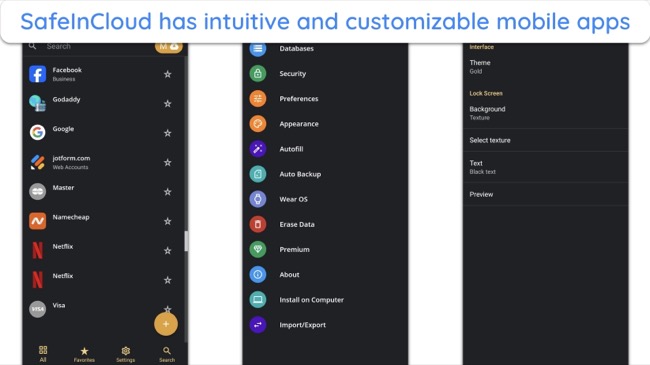
SafeInCloud’s mobile app integrates with WearOS and Apple Watch, a unique feature you don’t usually see. This lets you add cards to your smartwatch and easily access them with a quick flick of the wrist. You can’t do much other than view these cards, but this is a neat feature for sensitive information you often require on the go.
SafeInCloud’s desktop app has a setup checklist for new users. It helps you set up all the app’s key features when you start using it. This checklist helped me configure security settings, set up auto-fill, enable automatic backups, import passwords, and more.
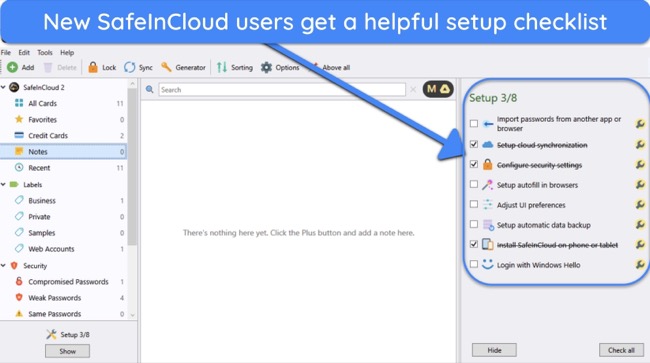
Setting up SafeInCloud on Windows
- Access SafeInCloud’s website. Open the SafeInCloud website and click the “Download” button to open the app’s download page.
![Screenshot showing how to access the downloads page on SafeInCloud's website]()
- Choose the Windows option. Choose the “Get it from Microsoft” option for Windows 10 and 11. There’s a separate option for Windows 7 and 8 if you’re using an older version of the OS.
![Screenshot showing how to get SafeInCloud for Windows 10 and 11]()
- Download SafeInCloud. Click on “Download” when SafeInCloud redirects you to the Windows store.
![Screenshot showing how to download SafeInCloud from the Windows store]()
- Launch SafeInCloud. Click “Open” to launch SafeInCloud after installing it on your system.
![Screenshot showing how to launch SafeInCloud after installing it]()
- Create a new database. Make a new database when you launch SafeInCloud for the first time.
![Screenshot showing how to create a new database in SafeInCloud]()
- Create a master password. Set a strong master password for your vault. SafeInCloud will let you know how secure your password is.
![Screenshot showing the master password creation menu in SafeInCloud]()
- Log into SafeInCloud. Log into SafeInCloud using the master password you set in the previous step.
![Screenshot showing the login page for SafeInCloud]()
- Access cloud sync options. Click “OK” when SafeInCloud asks if you want to configure cloud synchronization.
![Screenshot showing how to begin setting up cloud synchronization in SafeInCloud]()
- Choose Google Drive. Choose the Google Drive option in the available cloud storage methods. This is the simplest method that you can use with your Google account.
![Screenshot showing how to add Google Drive for cloud synchronization in SafeInCloud]()
- Set your database location. Choose the “App folder” option when SafeInCloud asks where to store your database.
![Screenshot showing how to choose your database storage location for SafeInCloud cloud storage]()
- Allow SafeInCloud Google account access. Click “Allow” when Google prompts you about SafeInCloud requesting access to your account.
![Screenshot of Google asking for confirmation to give SafeInCloud account access]()
- Close the sync menu. Click “Close” once you’ve successfully added your Google Drive to SafeInCloud.
![Screenshot of SafeInCloud after successfully setting up cloud synchronization via Google Drive]()
- Use SafeInCloud. Safeguard your passwords, cards, and other sensitive data with SafeInCloud.
![Screenshot of SafeInCloud after it's fully set up and ready to use]()
Overall, SafeInCloud offers a mostly solid user experience, with my only major concern being how long it is to set up if you want cloud synchronization enabled.
Support
Customer support is a weak point for SafeInCloud. The app only offers email support and an online knowledge base, while competitor apps also provide 24/7 live chat support. Also, SafeInCloud’s support is slower than its competition’s, meaning you might have to wait a while before getting the answers you need.
Email Support — Slow to Answer but Very Helpful
During my tests, SafeInCloud’s email support was slow to answer. I sent 2 emails with various questions; support took more than 36 hours to answer them. Thankfully, the answers were detailed and had the information I needed. Plus, customer support even explained why it took them so long to answer and apologized for the delay.
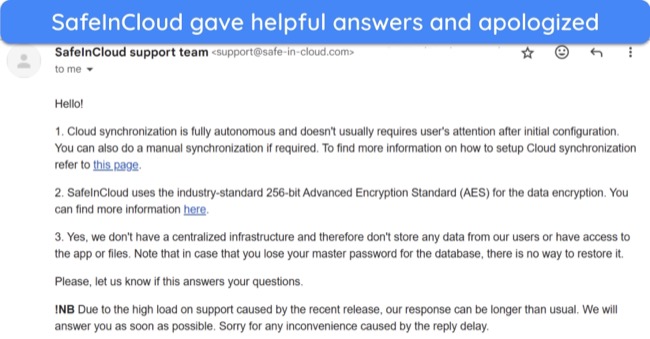
Online Knowledge Base — Extensive Resource With Various Helpful Support Articles
SafeInCloud has a comprehensive knowledge base that covers important information and will help you with basic setup issues and troubleshooting. The knowledge base helps set up the apps, use the various tools, and enable features like cloud sync.
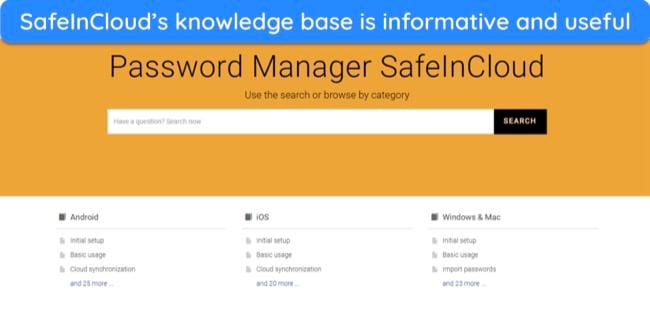
There’s also a useful search feature in SafeInCloud’s knowledge base that’ll quickly find what you need. I wanted to learn more about the app’s security measures, so I typed “Security” in the search bar and hit the Enter key. The search feature quickly found and listed relevant articles containing the required information.
Pricing
SafeInCloud is entirely free on desktop platforms, as it’s always been. There wasn’t a second-generation SafeInCloud release for desktops.
The first-generation SafeInCloud mobile app was only available as a one-time purchase, while the second-generation version has multiple subscription options and a free version. This is a good change, as it makes the app a smaller commitment than SafeInCloud 1.
Free Options — Completely Free to Use on Desktops but Limited on Mobile Devices
SafeInCloud’s desktop app is completely free to use and includes all features. There are no limitations to this version of the app, meaning you can download and use all its features on your desktop without a subscription.
On the other hand, SafeInCloud 2’s free mobile plan is very limited. It’s missing some key features, like the following:
- Cloud sync
- Biometric logins
- Password Generation
- Fast unlock
- Image/file attachments
- Smartwatch integration
Password storage is also limited on the free plan, but the amount of available storage isn’t mentioned anywhere. Thankfully, there are better free password managers that don’t limit functionality and work equally well on both desktops and mobile devices.
Paid Plans — Multiple Subscriptions for the Mobile App
You must purchase one of SafeInCloud 2’s paid subscriptions to use all its features across unlimited mobile devices. SafeInCloud 2 provides Individual and Family subscriptions, with the Individual plans being limited to 1 person and the Family plans allowing up to 6.
One standout feature is that the Family subscriptions include shared databases that are useful for shared logins that everyone uses.
For both Family and Individual subscriptions, SafeInCloud 2 provides monthly, yearly, and lifetime subscription options. The yearly subscription offers much better value than the monthly options. However, the lifetime option is the best overall value if this password manager meets all your needs.
Overall, I don’t think SafeInCloud 2’s paid options are worth the cost, regardless of your plan. The app is missing several key features like passkey support, secure sharing, and emergency access, which its competitors offer at cheaper prices.
Free Trial — 14 Days to Try the Mobile App Risk-Free
SafeInCloud’s second generation offers a 14-day trial for its mobile subscriptions. You can sign up for the trial via your device’s app store and won’t get charged until it expires. The trial includes all the premium features for its mobile subscriptions, meaning it’ll let you try SafeInCloud risk-free to see if it suits you.
Refunds — Based on Your App Store’s Refund Policies
SafeInCloud handles subscriptions via the Apple and Google stores. So, you can only get a refund if you qualify for one under your app store’s policies.
Thankfully, both Google and Apple are lenient with refunds on the app stores if you haven’t used an app for too long or have a valid case. So, if you’re truly unsatisfied with the app, you can submit a request asking for a refund and explain why. If your request is valid, you’ll get your money back within a few days.
Bottom Line
SafeInCloud is suitable for basic password management, but only if you use its free desktop apps. The free mobile apps have minimal functionality, and paying for them isn’t worth it, as you only get simple features that aren’t worth the price.
Unfortunately, SafeInCloud lacks advanced features, regardless of your plan or platform. It doesn’t have proper auditing tools, secure password sharing, emergency access, two-factor authentication for vaults, and several other features. So, it’s not good if you want comprehensive password safety and advanced password management features.
Dashlane is a much better alternative. Its free plans are better than SafeInCloud’s free options, and the paid subscriptions deliver excellent value. It includes advanced password auditing, emergency access, safe sharing, and a VPN for added online protection. Plus, you can try Dashlane risk-free, as it comes with a 30-day money-back guarantee.
FAQs on SafeInCloud
Is SafeInCloud a good password manager?
SafeInCloud is a decent option. However, the app is missing important tools many top password managers offer, like passkey support, emergency access, secure password sharing, and more.
Alternatives like 1Password proved to be much better in my tests. With 1Password, you get a more comprehensive vault, better password auditing, safe password sharing, passkey support, and more.


